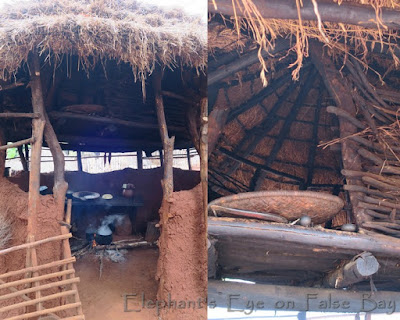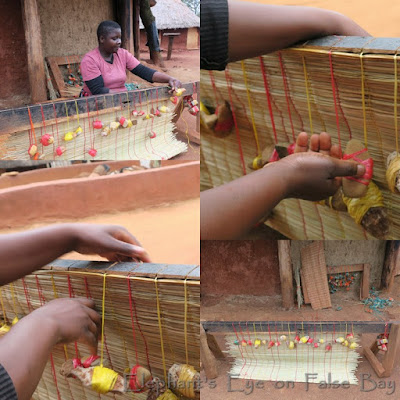Pilgrim's Rest to Cape Town (heading home from Kruger Park)
by Diana Studer
- gardening for biodiversity
in Cape Town, South Africa
Heading home from Kruger Park in September (It was the free
entry to South Africans week - delighted to see crocodiles of wide eyed tiny
kids and their hobbling grannies). Idle and Wild in Hazyview
was a spacious delight. A lush green subtropical garden on a macadamia farm.
Welcomed with a vase of pink azaleas from the garden. The only place to supply real fresh milk in the fridge (tea with
non-dairy creamer or long life 'milk' tastes awful)
Pilgrim's
Rest. Stitch in time remembering miners from Cornwall and Wales looking for
their fortune in gold. We arrived early, before the coaches.
Imagine cooking over a coal stove in blistering summers. The
Celtic cross for a miner from Truro reminding me of my mother learning French
at high school there.
Three marble angels in the cemetery. In the doctor's house
one of those quaint Victorian photos posing a dead child, with the catchlight
and lace details painted in by an artist. My father and his sister were skilled
photographers and aunt Nerina did that adding colour to black and white photos,
but with a delicate touch. I am haunted by that still child.
At the Shangaan
village in Hazyview. A bit theme park with skilled actors. Grain was stored
above the kitchen, where there is always smoke from the fire to keep wildlife
away from the food in the roof.
Traditional healer or sangoma with her herbal remedies.
Roots and bulbs, dried herbs powdered and stored in a gourd. Solanum used in careful doses.
The young woman weaving her reed mat. She lays one reed one
top, then flips alternate bobbins back and forth to lock in that reed. I have a
wooden bobbin from Swiss lace makers, but plastic twine (with the same sliding
knot) around a stone works just the same. That twine would originally have been
sisal.
Our last night before the return train journey was Arum Place in Melville. Happy
sigh. We sat on the terrace, sipping tea, watching the sun set over
Johannesburg's urban forest. And a pair of loeries canoodling in the nearest
tree. We had to leave very early to load the car on the train, and much appreciated a
breakfast of muesli with fresh fruit for me, and freshly baked croissants for
my Swiss husband.
Longyuan
Mulilo wind farm at De Aar providing electricity and employment to the
Northern Cape.
The Karoo landscape much enjoyed as we clickety-clicked
along.
My father was involved in planning the train route
through the Hex River Valley - glorious iconic Cape scenery of mountains and
vineyards (- Hex was named for Eliza who died of a broken heart).
The return journey was again delayed by a locomotive which
needed to be replaced mid-journey. Dawn at De Aar. Sadly we arrived in Cape
Town after dark and missed that famous view of Table Mountain.
2 Cape Town to the Limpopo River - the journey up
4 Elephants and friends
5 Clivia and Gerbera at home Walter Sisulu and Lowveld National Botanical Gardens
4 Elephants and friends
5 Clivia and Gerbera at home Walter Sisulu and Lowveld National Botanical Gardens
I invite you to join us at Elephant's Eye on False Bay.
Please subscribe as you prefer
via Feedly,
or Bloglovin,
or Facebook
Teal blue text is my links.
To read comments if you are in email or a Reader,
first click
thru to the blog)
Thanks for comments that add value. Maybe start a new thread
of discussion? BTW your comment won't appear until I've read it. No Google
account? Just use Anonymous, but do leave a link to your own blog. I would
return the visit, if I could...
I welcome comments on posts from the last 2 months.











What a glorious land is SA. Thank you for sharing it with someone far far away.
ReplyDeleteOnce again, you packed a lot into your journey. Although I always enjoy seeing the wide and varied flowers and plants that pepper your posts, this one with its historical and cultural content is interesting too. Poor foolish Eliza!
ReplyDeleteHow fascinating that your father helped plan the train route. He must have had some stories! The history you share about your journey and the people there--also fascinating. Weaving was (and still is) such an important part of so many cultures. So wonderful to watch people as they weave.
ReplyDeleteI need to sort thru his letters to my mother.
DeleteHi Diana, I hope I am commenting correctly through Google this time!
ReplyDeleteI very much enjoyed your story of travelling back down to Cape Town. You must be very proud of your father, contributing to the train route. What an amazing feat to build that railway. A few years ago we travelled through the Little Karoo, and the Hex River Valley. The scenery was breathtaking, this was one of my favourite parts of our travels through South Africa, and not very well known.
After the Second World War my mother came back to Cape Town, (from the UK) and as the ship got closer to Cape Town, she stayed up all night to see Table Mountain at dawn, as the ship sailed into harbour.
Reminds me of travelling by ship from Cardiff via St Helena. An English woman (adopted from the island) meeting her brother for the first time. And then standing on the bridge of the ship with her, seeing Table Mountain for the first time 'thru her eyes'
DeleteI never realized before how large South Africa is.
ReplyDeleteWe used to have a tourism tagline - a world in one country ;~)
Delete- a Pilgrim's Rest comment via email -
ReplyDeleteA similar coal/wood stove cooked our meals, heated water for bathing and kept us warm when needed. I baked my first cake in such a stove, no thermometer so had to ask my Mom how many pieces of wood to put into the stove to get the correct temperature.
My parents emigrated to South Africa in 1969. We actually arrived into Table Bay (Pendenis Castle) on New Year's day. I was 7 years old but I remember vividly the site of Table Mountain rising from the see in the dawn light. I enjoyed reading your travel blog.
ReplyDeleteAnd mine - my father from New Zealand met my mother in London. During the Depression and the job he was going to was filled while they were on the ship. So he became a railway engineer instead.
DeleteI wish I could do this journey myself, you saw amazing places. What a pity with the train breaking down.
ReplyDelete